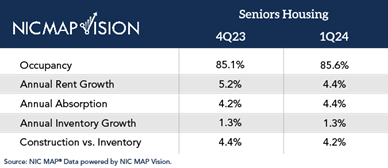ANNAPOLIS, Md. — The occupancy rate for private-pay seniors housing rose 50 basis points to 85.6 percent in the first quarter of 2024, according to data from NIC MAP Vision. It’s the 11th consecutive quarterly increase in occupancy as the industry continues to recover from impacts of the COVID-19 pandemic.
The occupancy figure marks an increase of 780 basis points from the pandemic low of 77.8 percent in second-quarter 2021, but still just shy of the pre-pandemic mark of 87.1 percent in first-quarter 2020.
NIC MAP Vision is a product of the National Investment Center for Seniors Housing & Care (NIC), an Annapolis-based nonprofit firm that tracks industry data gathered from 31 primary metropolitan markets. Private-pay seniors housing comprises independent living, assisted living and memory care.
Net absorption in the first quarter totaled roughly 5,000 units, a more than 40 percent increase over the level of absorption in the first quarter of 2023, according to NIC.
“The continued upward climb of occupancy along with strong absorption levels supports the NIC forecast of returning to and surpassing the pre-pandemic occupancy levels sometime in 2024,” says Lisa McCracken, NIC’s head of research and analytics.
Construction starts increased slightly from the fourth quarter of 2023 to 2,236 new units started in the first quarter of 2024, with assisted living moderately above independent living starts. Despite a slight uptick in new projects in the first quarter, the rolling four-quarter average for construction starts sits at 1.37 percent of total inventory, the lowest level since first-quarter 2010. Higher costs of capital and challenged lending environment conditions continue to weigh on new supply.
“With little change in access to capital and in borrowing costs, particularly for new projects, we continue to see depressed levels of construction starts,” says Caroline Clapp, senior principal with NIC. “We expect this trend to continue until financing conditions ease.”
To view the full report, click here.

